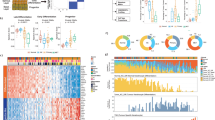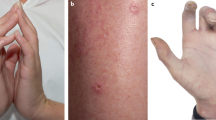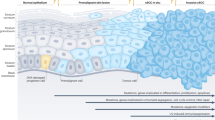Abstract
Renal allograft recipients (RARs) have a well-documented increased incidence of viral warts and cutaneous neoplasia, particularly those with long graft life and high sun exposure. A clinicopathological survey of 69 RARs in south-east Scotland, with follow-up periods of up to 28 years after transplantation, revealed marked variation in patient susceptibility to cutaneous malignancy with concomitant variation in HPV prevalence. Skin cancers were found in 34 patients. Eight patients showed high susceptibility [defined as more than four intraepidermal carcinomas (IECs) or invasive squamous cell carcinomas (SCCs)] 42 had intermediate susceptibility (1-3 IECs or SCCs, or >3 keratoses) and 18 had low susceptibility (< or = 3 keratoses and no cancers). SCCs, IECs and keratoses from the high-susceptibility group were found to have greater prevalences of human papillomavirus (HPV) DNA (56%, 45% and 50% respectively), than SCCs (0%) and IECs (33%) from intermediate-susceptibility RARs and keratoses (36%) from the combined intermediate- and low-susceptibility groups and compared with a group of immunocompetent controls (27%, 20% and 15% respectively). No differences in p53 protein accumulation, determined immunohistochemically, were observed in tumours from the three groups. Categorization of RARs by susceptibility to cutaneous malignancy provides clinically useful information, as significantly more high-susceptibility patients (38%) developed aggressive, potentially lethal anogenital or cutaneous squamous cell cancers than did patients in the intermediate group (5%, P=0.005) or the low-susceptibility group (0%).
This is a preview of subscription content, access via your institution
Access options
Subscribe to this journal
Receive 24 print issues and online access
$259.00 per year
only $10.79 per issue
Buy this article
- Purchase on Springer Link
- Instant access to full article PDF
Prices may be subject to local taxes which are calculated during checkout
Similar content being viewed by others
Author information
Authors and Affiliations
Rights and permissions
About this article
Cite this article
Arends, M., Benton, E., McLaren, K. et al. Renal allograft recipients with high susceptibility to cutaneous malignancy have an increased prevalence of human papillomavirus DNA in skin tumours and a greater risk of anogenital malignancy. Br J Cancer 75, 722–728 (1997). https://doi.org/10.1038/bjc.1997.128
Issue Date:
DOI: https://doi.org/10.1038/bjc.1997.128
This article is cited by
-
Pediatric Onco-Nephrology: Time to Spread the Word-Part II: Long-Term Kidney Outcomes in Survivors of Childhood Malignancy and Malignancy after Kidney Transplant
Pediatric Nephrology (2022)
-
The transplant cohort of the German center for infection research (DZIF Tx-Cohort): study design and baseline characteristics
European Journal of Epidemiology (2021)
-
Common Variable Immunodeficiency Disease and Rectal Squamous Cell Carcinoma: a Case Report of a Rare Syndromic Tumor Type
Journal of Gastrointestinal Cancer (2016)
-
Giant anal condyloma (giant condyloma acuminatum of anus) after allogeneic bone marrow transplantation associated with human papillomavirus: a case report
Journal of Medical Case Reports (2015)
-
Prevalence of high-risk human papillomavirus cervical infection in female kidney graft recipients: an observational study
Virology Journal (2012)



